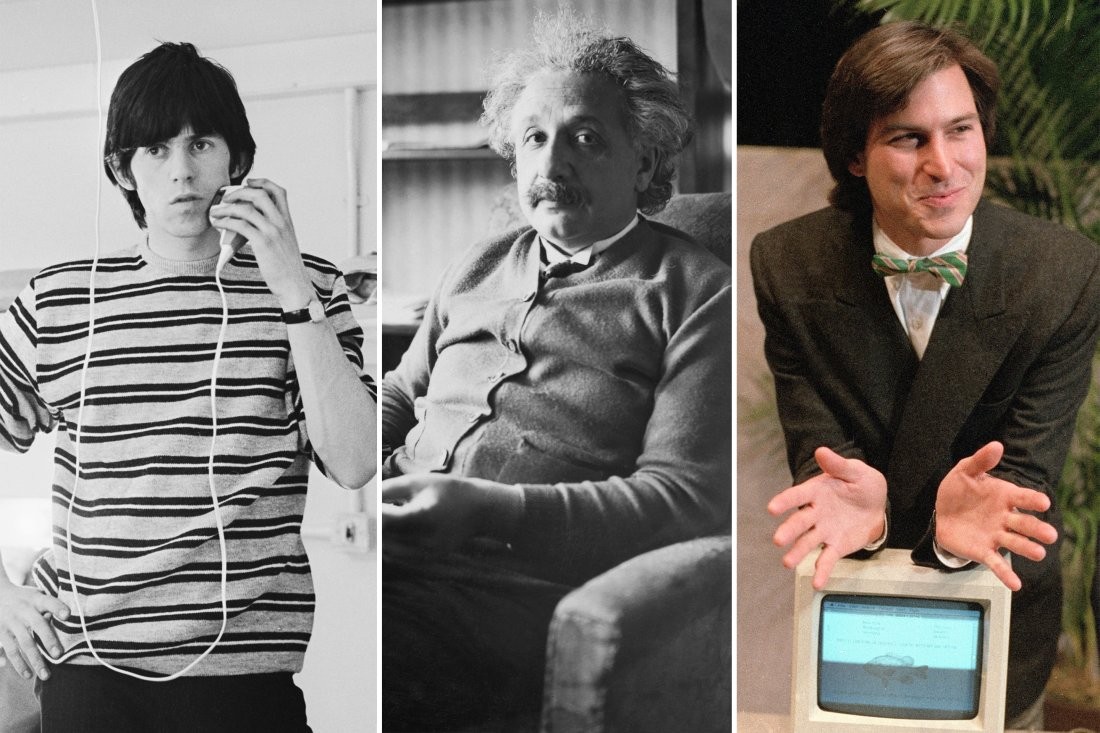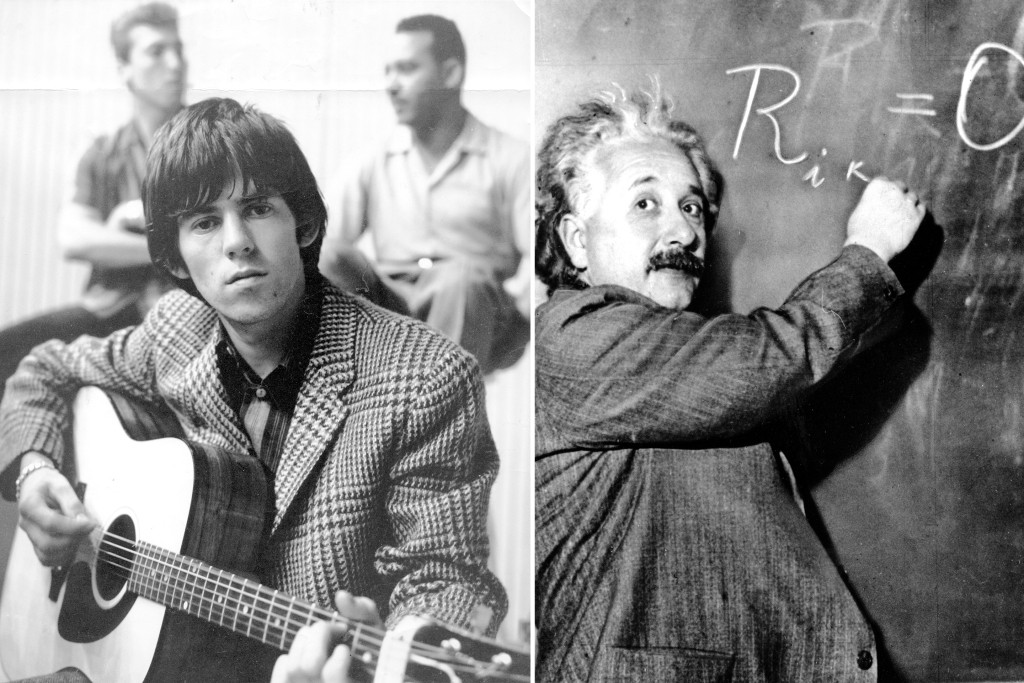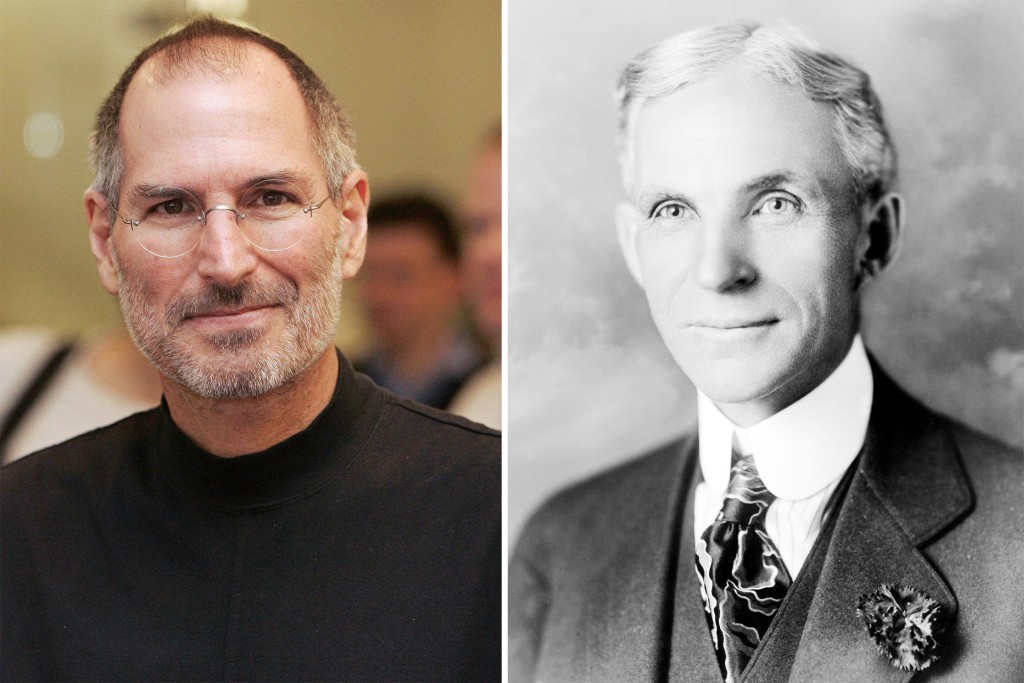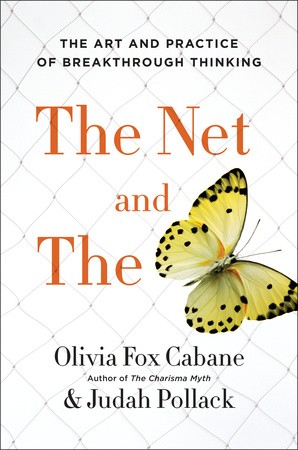如何像发明大师一样拥有突破性思维

基思·理查兹(左)、阿尔伯特·爱因斯坦与史蒂夫·乔布斯
|
你可以学会如何想出优秀的创意。这是奥利维亚·福克斯·卡班与朱达·波拉克在《网与蝴蝶:突破性思维的艺术与实践》(The Net and the Butterfly: The Art and Practice of Breakthrough Thinking)一书中做出的大胆承诺。卡班是《魅力之谜》(The Charisma Myth)一书的作者,她与波拉克曾在斯坦福大学的创业孵化器任职;目前,两人为许多优秀公司提供咨询服务,包括谷歌(Google)、Airbnb、IDEO、德勤(Deloitte),甚至美国陆军特种部队。《网与蝴蝶》一书不仅用轶事趣闻讲述了著名创意的诞生,还提供了一系列实践练习,目的是提高读者产生卓越创意的能力。下文的编辑节选内容,探讨了最有益于创造力的精神状态,并用示例讲解了如何进入这种状态。最后一段讲述了创意“诞生过程”通常包含了在原始的思想火花迸发之后,对创意的修改和合并。——《财富》 1965年。佛罗里达州克利尔沃特。当时的滚石乐队仍籍籍无名。在一个闷热潮湿的清晨,基思·理查兹在一家汽车旅馆的客房里醒来,看到了床上的吉他和一台录音机。头昏脑胀、宿醉未醒的理查兹把磁带倒了回去,按下了播放键。在这张长达一个小时的磁带中,他自己打鼾的声音占了59分钟。但前30秒却成为了滚石乐队最标志性畅销单曲《Satisfaction》的开头和第一句歌词。他根本不记得自己碰过录音机。 不论你是否相信,理查兹获得突破性时刻的模式,与阿尔伯特·爱因斯坦发现狭义相对论的模式完全相同。我们在为本书采访世界上最伟大的创新者的过程中,曾无数次耳闻这种模式。如果你在洗澡的时候也曾有过灵光一现,那你肯定也有过同样的经历。 如果你出现了这种“淋浴时刻”,很有可能你当时正在思考某件事情,可能是工作中的问题,或者人际关系上的麻烦。你肯定一直在思考这个问题,希望找到不同的解决办法。然后你开始淋浴,水在你身上流淌,你的意识也开始信马由缰。你不再专注于一件事。突然,答案如晴天霹雳一般出现在你的脑海中。你的淋浴时刻与基思·理查兹和阿尔伯特·爱因斯坦的发现之间有什么共同点?当你开始淋浴时,你已经无意识地切换了大脑的模式。之前,你一直有意识地专注于问题。但在淋浴时,你的意识进入了漫游状态,无所事事地做着白日梦,或者好像是“什么也没想”。神经科学家最近发现,突破的秘密在于,我们能够在专注与漫游这两种模式之间切换。 |
You can learn to cultivate great ideas. That’s the bold promise of The Net and the Butterfly: The Art and Practice of Breakthrough Thinking, by Olivia Fox Cabane and Judah Pollack. Cabane is the author of The Charisma Myth and both she and Pollack used to work at Stanford University’s start-up accelerator; the two now consult variously for prominent companies and organizations ranging from Google, Airbnb, and IDEO to Deloitte and even the U.S. Army Special Forces. The Net and the Butterfly is filled not only with anecdotes describing the births of famous ideas, but also with a series of practical exercises aimed at improving your ability to generate them. The edited excerpts that follow examine the states of mind that are most conducive to creativity along with a few examples of how to achieve those states. The final passage explores how idea “creation” often consists as much of idea modification and combination as of the original spark.—Fortune *** THE YEAR WAS 1965. The place was Clearwater, Fla. In his motel room—the Rolling Stones weren’t yet famous enough to afford hotels—Keith Richards woke up on a hot, humid morning to find his guitar and a tape recorder on the bed beside him. Groggy and hungover, Richards rewound the tape and pressed play. The hourlong tape contained 59 minutes of his own snoring. But the first 30 seconds held the opening bars and first lyric of what became the Rolling Stones’s most iconic hit, the song “Satisfaction.” He didn’t remember even touching the tape recorder. Believe it or not, Richards’s breakthrough moment follows the very same pattern as Albert Einstein’s discovery of the special theory of relativity. It’s the pattern we heard again and again when we interviewed some of the world’s greatest innovators for this book. And it’s the same pattern you’ve experienced if you’ve ever had a sudden epiphany in the shower. Whenever you have a “shower moment,” chances are something was on your mind, like a problem at work or an issue in a relationship. You’d probably been mulling over the problem, trying to work it out in different ways. Then you stepped into the shower. Your mind wandered off as the water poured over you. You were no longer focused. Suddenly, seemingly out of the blue, the answer came to you. What do your shower moments have in common with both Keith Richards’s and Albert Einstein’s discoveries? When you got into the shower, you unknowingly switched brain modes. Previously, you had been consciously focusing on the problem. But in the shower, your mind was probably drifting, idly daydreaming or seemingly “thinking about nothing.” Neuroscientists have recently discovered that the secret to breakthroughs lies in our ability to switch between these two modes, the focused and the meandering. |

基思·理查兹与阿尔伯特·爱因斯坦。
|
对于专注模式我们早已不陌生,因为我们生活中一直在有意识地使用这种模式。你可以把它看作是“执行模式”:是人类用于执行和完成任务的模式。这种模式以目标为导向,专注于最终期限,擅长制定清单、遵照时间安排和遵守预算。大脑中负责这种模式的部分被称为执行网络。 执行网络是在颅骨前方附近的一组大脑分区,负责帮助人类专注于任务和实现特定目标。人类非常擅长使用执行网络。毕竟,我们在学校中至少花了十多年的时间,专门训练这些分区。事实上,阅读这句话的时候,你正在调用你的执行网络。通过执行网络,你可以成为(我们希望如此)有用、负责和高效的社会成员。 但仅靠执行网络并不能带来突破。它还需要漫游网络——即创造淋浴时刻的部分——提供帮助。这就是我们的创意网络——默认网络。你可以把默认网络看作是大脑中的突破性天才组成的网络或委员会。这些天才不断地谈论和交流创意、不完善的理论和大胆的猜想。 默认网络是所有创意、发明和才华的来源,但它的作用尚未得到充分的认可。默认网络在人类历史上取得过哪些成就?或者换一种更好的问法,它在哪些伟大发现中发挥了作用?如果说执行网络赋予了人类专注和完成任务的能力,默认网络则赋予了人类透过世界的复杂表象找出规律的能力。 默认网络是人脑中一个非常重要的组成部分:研究已经确认,大脑的这一部分对于人类生存的重要性,不亚于心脏或肾脏。它如此重要,甚至我们可以用一整本书的篇幅来讲述它。我们可以说:“这就是它。它这样运行,你可以这样使用它,或者你可以这样挖掘它的潜力。”但事实上,这还不够。仅靠默认网络也无法带来突破。 基思·理查兹创作出《Satisfaction》,阿尔伯特·爱因斯坦发现狭义相对论,发挥作用的都是利用这两种模式并在之间相互切换的能力。事实上,正是这种能力才诞生了人类历史上的多数惊人发现 那么,我们如何使用天才模式?一种方法是睡觉。(千真万确。) 亚当·切耶尔是苹果iPhone手机人工智能语音助手Siri的发明者。创造Siri是一项艰巨的设计与编程任务。海量的变量、理解不同语言模式的能力、基于人们要求信息的随机方式进行搜索的能力,以及以有效的方式提供答案的能力等等,每一项都是巨大挑战。幸运的是,切耶尔有一件秘密武器:随时进入天才模式。 尽管设计和创造Siri是一项高度结构化的任务,但切耶尔清楚,他不能按照逻辑的方式,去努力找到所有的答案。相反,他告诉我们:“我会带着正在努力解决的问题睡上一觉。”和托马斯·爱迪生一样,切耶尔也发现那种入睡前和觉醒前半睡半醒的朦胧状态具有令人难以置信的突破能力。有时候,我们的天才委员会会高度紧张地运行。 他解释说:“我在11点左右上床,一边苦思冥想一个问题,一边入睡。”切耶尔“苦思冥想”问题的时候,有意识地调用了执行网络,使他的天才委员会专注于问题。他依靠天才委员会形成新的关联,在睡眠过程中取得突破。而在早上醒来后,他会在桌子前,利用执行网络处理昨天晚上所收获的创意。 在最初设计Siri的过程中,他每天早上醒来,都会从默认网络获得新的见解。之后他利用执行网络,将这些见解纳入正在设计的原型。最终,他感觉自己的设计已经足够形象,可以展示给全世界。 |
The focused mode is one you are already familiar with, because it’s the one you have been consciously using all your life. You can think of this mode as the “executive mode”: it’s the one you use to execute, to get things done. Goal oriented and deadline focused, it’s a champion at making lists, following timelines, and coming in under budget. The part of your brain responsible for this mode is called the executive network, or EN. The EN is a group of brain regions near the front of your skull that help you focus on a task and accomplish a specific goal. You’re very well versed in the use of your EN. You did, after all, spend at least a decade in school specifically training those brain regions. As a matter of fact, you’re using your EN right now to read this sentence. With your EN you are (we hope) a functional, responsible, and productive member of society. But your EN alone can’t create breakthroughs. It needs help from the more meandering network, the one that creates shower moments. This is our creative network, the default network, or DN. You can think of the DN as a network or council of breakthrough geniuses inside your brain. The geniuses talk and exchange ideas, half-baked theories, and wild speculations. The DN is the source of all our creativity, all our invention, all our genius—and it hasn’t gotten nearly enough recognition. What has the DN accomplished throughout history? A better question would be what great discoveries hasn’t it played a role in. If the EN gives us the ability to focus and accomplish a task, the DN gives us the ability to look through the complexity of the world to see the patterns underneath. The DN is a vital component of your brain: Research has made clear that this part of your brain is as essential to your survival as your heart or your kidneys. It’s so important, in fact, that we could have written this entire book all about the DN. We would have said, “Here it is! Here’s how it works, here’s how you can access it, here’s how you can turbocharge it.” But in fact, that’s not enough. The DN, alone, can’t create breakthroughs. It’s the ability to use both modes, to switch from one mode to another, that enabled Keith Richards to come up with “Satisfaction” and Albert Einstein to discover the special theory of relativity. In fact, it’s what enabled most discoveries in human history *** So how can you access your genius mode? One way is to sleep on it. (Yes, really.) Adam Cheyer is the creator of Siri, Apple’s artificial intelligence iPhone voice assistant. Building Siri was a Herculean design and programming task. The sheer number of variables—the ability to understand varying speech patterns, the ability to search based on the random ways people would request information, the ability to return answers in a useful way—were each a massive challenge. Thankfully, Cheyer had a secret weapon: ready access to his genius mode. Although designing and building Siri was a highly structured task, Cheyer knew better than to try to logically grind out every answer. Instead, he told us, “I sleep on the issues I’m wrestling with.” Cheyer, like Thomas Edison, has discovered the incredible breakthrough power of the hypnagogic and hypnopompic states, the half-asleep periods just before falling asleep and just before waking. These are times when our genius council runs on hyperdrive. “I go to bed around 11, noodling on a problem as I fall asleep,” he explained. By “noodling” on the problem, Cheyer uses his EN to deliberately and consciously focus his genius council on a question. He relies on his genius council to make new associations and deliver breakthroughs while asleep. In the morning he goes to his desk and uses his EN to process the night’s harvest of ideas. Morning after morning while first designing Siri, he would wake up with new insights from his DN. He’d use his EN to integrate them into the prototype he was building. Eventually, he felt that he had something concrete enough to show the rest of the world. |

亚当·切耶尔与托马斯·爱迪生。
|
入睡前和觉醒前的状态提高创造力的效果显著,因为我们的抑制性额叶,即执行网络的“行政办公室”所在地,处在安静状态,而默认网络却在高强度运行。 实践:如何进入入睡前状态 — 清理房间内的杂物和干扰物。 — 准备好纸笔、录音机,手机调至飞行模式,准备记笔记,或者…… — 将灯光调暗(或戴眼罩)。 — 确保处在一个安静的环境中,或者只能听到白噪声。 — 不要过于舒适——不要穿睡衣或者躺在床上。 — 尽量选择中午时间或饭后,这时候你会感到适度的疲劳。 — 设置10至15分钟闹钟。 — 拿出一点时间让大脑专心思考问题,然后随它去。放松,迷迷糊糊地睡去。 经常开小差的人可以证明,仅仅休息一会儿不会带来灵感:要想激发创造力,必须执行能够让意识漫游的任务。 经过一次关于“不同寻常用途”的创造力测试(“你可以用衣架做多少事情?”)之后,学生们休息了12分钟。一组单纯地进行休息;一组执行简单的、不需动脑的任务;一组进行高要求的记忆游戏;另一组不休息。 当参与者重新进行创造力测试时,进行“不需动脑的任务”的小组,其表现平均提高了41%。相反,其他三组的表现没有任何提高。 有趣的是,这种情况仅适用于已经在绞尽脑汁思考的问题;完成一件不需要动脑的任务,似乎并不能带来创造性问题解决能力的整体提高。这是有道理的:为使天才们高效率的工作,我们的高管必须给他们制定明确的目标。 我们的客户经常问:“有没有一种最好的不需动脑的活动?”如果一定要选出一种,我们认为是步行。 在最近的研究中,参与者在室内面朝空白墙壁的跑步机上步行或在空气新鲜的户外步行,他们所提供的创造性回答,比坐着不动的参与者多一倍。 首席研究员表示:“我认为在户外步行最为有效。不过在狭小沉闷的房间里在跑步机上步行,也有很好的效果。”研究还发现,即使在步行之后重新坐下,依旧可以诞生大量的创意灵感。“我们知道步行会议能够提高创造力,但在开会之前步行可能也有类似的效果。” 从认知的角度,步行仅需要执行网络适量的关注。步行是一项非常复杂的任务: 我们要不断接收脚、腿、臀、臂,以及作为人体平衡陀螺仪核心的内耳的信息输入。但人脑却是处理这项任务的专家。凭借长久以来对这项任务的熟悉,执行网络仅需要为此投入很少的精力。 而从生理的角度,步行能够刺激大脑。促进血液流动可以给大脑带来一连串的其妙变化,包括释放脑源性神经营养因子和其他增长因子。脑源性神经营养因子可以促进新神经元的诞生和新神经突触的形成,并且可以加强现有的神经突触。 对于开放办公室的褒贬不一,但由于开放办公室的内墙和移动办公桌更少,因此至少它们更适宜步行。事实上,据斯坦福大学的研究显示,开放空间对于创造力而言最重要的就是支持步行的能力。研究发现,步行可以将员工的创造性输出提高60%。 众所周知,查尔斯·达尔文有一条著名的四分之一英里长的步行小径,名为“沙之小路”,在解决一个问题时,他会在这条小路上边走边思考。“步行对于他的思考过程如此重要,以至于达尔文有时候会把正在解决的问题,换算成解决这个问题需要在这条小路上走完的圈数。” 梅森·柯里在研究了古往今来世界上近200位最多产的发明家和创新者的习惯之后发现,这些伟大的发明家和创新者都有一个共同的习惯——步行。柯里在报告中写道,查尔斯·狄更斯每天下午会步行3个小时,而他在步行过程中所观察到的事物,都直接变成了写作的灵感。 柴可夫斯基虽然会勉强走完2个小时,但他绝不会提前返回一分钟,因为他认为,欺骗自己完整走完了120分钟,会让他感到不舒服。贝多芬在午饭后会长时间散步,他会随身携带一支铅笔和纸,以记录突然降临的灵感。 索伦·克尔凯郭尔曾经说过:“我用散步来成就我最好的思维。”有报告说,他经常戴着帽子,拿着拐杖或雨伞,急匆匆地冲回到桌子前继续写作。 为了实现意识漫游,在安静平和的地方步行效果良好; 如果你需要注意汽车、交通灯、慢跑者等,步行的效果会变差,因为你必须始终保持活跃的执行模式。不论为了让意识漫游还是有目的的步行,均取决于你自己:朱达喜欢漫无目的地步行,但奥利维亚需要一条路线和一个目的地。 事实是这样的:并非你只需要去走一走,然后就能神奇地获得突破性。步行是设定条件的有效方式,但除了漫无目的地游荡,灵感的产生还需要更多因素。将之投入实践涉及许多步骤,包括确定问题和制定目标。用语言描述自己正在寻找什么,可以让你迈出寻找答案的第一步。你还需要随身带一本笔记本,以便于始终有地方可以记录自己的想法。还有许多更意想不到的技巧:手中拿点东西。一枚硬币、一块石头、一个曲别针、一个星球大战的人偶等等。人手会向大脑发送海量的信息,而保持这些信息渠道开放,可使大脑处在一种更关联的状态。苹果公司的亚当·切耶尔总是会在桌子上放一个魔方,在思考的时候随手把玩。 “创新就是将事物联系在一起。你问有创造力的人是怎样做事的,他们会觉得有点不好意思,因为他们其实并不是在创造,只是自然而然地看到了一些东西……因为他们能联系到自己从前的经历,进而合成新的事物。” |
The hypnagogic and hypnopompic states are so fruitful for creativity because our inhibiting frontal lobes—where our EN’s front office is located—are quiet, and our DN is running strong. *** Putting it into practice: How to enter the hypnagogic state — Clear the room of clutter and distractions. —Have pen and paper, voice recorder, your phone on airplane mode and set to take notes, or . . . —Dim the lights (or wear an eye mask). —Ensure you’re in a quiet place, or that only white noise is audible. —Don’t get too comfortable—no wearing pajamas or getting in bed. —Try to find time at midday, or right after you’ve eaten, when you’re just the right amount of tired. —Set your alarm for ten to fifteen minutes. —Take a moment to focus your brain on the problem, and then let it go. Relax and drift off. *** As anyone who zones out all the time can testify, simply taking a break will not lead to inspiration: To stoke creativity, you need to perform tasks that allow your mind to wander. After an “unusual uses” creativity test (“How many things can you do with a hanger?”) students were given a 12-minute break. One group simply rested; one did an easy, mindless task; one did a demanding memory game; and one group took no break. When the participants reconvened and retook the creativity test, the “mindless task” group performed an average of 41% better. By contrast, participants in the other three groups showed no improvement. Interestingly, this was only the case for problems that were already being mentally chewed on; doing a mindless task didn’t seem to lead to a general increase in creative problem-solving ability. This makes sense: Our executive has to have set a clear goal for our geniuses in order for them to be productive. “So what’s the single best mindless activity I can do?” our clients often ask us. If we had to choose one single mindless activity, it would be walking. In a recent study, participants walking indoors on a treadmill facing a blank wall or walking outdoors in the fresh air produced twice as many creative responses compared to those who were sitting down. “I thought walking outside would blow everything out of the water,” said the lead researcher, “but walking on a treadmill in a small, boring room still had strong results.” The study also found that creative juices continued to flow even when a person sat back down shortly after a walk. “We know walking meetings promote creativity, but walking before a meeting may be nearly as useful.” From a cognitive angle, walking demands just the right amount of focus from our executive, without asking too much. Walking is a very complex task: We are taking in constant input from our feet, legs, hips, arms, and, of course, our inner ears, the heart of our balance gyroscope. But our brains are experts at this task. Through long familiarity, the executive can do all this with very little energy. From a physical angle, walking stimulates your brain. Increased blood flow causes a cascade of wonderful changes in the brain, including the release of brain-Derived neurotropic factor (BDNF) and other growth factors. BDNF promotes the birth of new neurons and the formation of new synapses, and it also strengthens existing synapses. Open offices have strong detractors as well as proponents, but with their few inner walls and rolling tables, they’re at least walker friendly. In fact, according to research out of Stanford, the most important thing these open spaces offer to creativity is the ability to walk. Doing so increased a person’s creative output by 60%, the study found. Charles Darwin famously had a quarter-mile-long walking path called the Sandwalk that was his place to go and think when working on a problem. “So important was walking to his thought processes that Darwin sometimes described a problem he was working on in terms of the number of turns around his path he would need to solve it.” Mason Currey, after studying the habits of nearly 200 of the world’s most prolific inventors and innovators over the ages, found that the single common habit of these great inventors and innovators was walking. As Currey reports, Charles Dickens famously took 3-hour walks every afternoon—and what he observed on them fed directly into his writing. Tchaikovsky made do with a 2-hour walk, but wouldn’t return a minute early, convinced that cheating himself of the full 120 minutes would make him ill. Beethoven took lengthy strolls after lunch, carrying a pencil and paper with him in case inspiration struck. Soren Kierkegaard is quoted as saying “I have walked myself into my best thoughts.” He is also reported to have often rushed back to his desk and resumed writing, still wearing his hat and carrying his walking stick or umbrella. Walking, when used for mind-wandering, works well in quiet, peaceful places; less well when you have to be aware of cars, traffic lights, joggers, and so forth, because your executive mode has to stay active. Whether to meander or to walk with purpose is up to you: Judah is comfortable walking aimlessly, but Olivia needs a route and a destination. Here’s the thing: you don’t just take a walk and magically have a breakthrough. Walking is a wonderful way to set the conditions, but there is more to it than simply meandering along. Putting it into practice involves multiple steps, including defining your problem—the act of verbalizing what you’re looking for can get you started on finding the answer—and setting a goal. You’ll also need to carry a notebook so you always have a way to record your thoughts. And then there are the more unexpected techniques: Keep something in your hand. A coin, a stone, a paperclip, a Star Wars figurine—we won’t judge. Our hands send massive amounts of information to our brains, and keeping those channels open keeps our brains in a more associate state. Adam Cheyer of Apple always keeps a Rubik’s Cube on his desk to play with while thinking. *** “Creativity is just connecting things. When you ask creative people how they did something, they feel a little guilty because they didn’t really do it, they just saw something. . . . That’s because they were able to connect experiences they’ve had and synthesize new things.” |

史蒂夫·乔布斯与亨利·福特。
|
史蒂夫·乔布斯在这段话中所描述的就是“关联思维”,是突破性思维的核心。我们常常错误地认为突破就是独立的想法,是之前没有任何人在任何情况下想到的事物。但事实上,几乎所有突破都综合了当前已经存在的各种想法。 亨利·福特的生产流水线创举,结合了芝加哥肉类加工行业使用机械吊钩和面包房使用工业传送带之间的联系。他将两者结合用于汽车生产,生产流水线由此诞生。 武器精准度的突破也是因为枪械制造商研究了弓和箭。箭尾的羽毛使箭旋转,而旋转则让箭能够直线飞行。同样,螺旋抛出的足球也可以直线飞行。为了让子弹旋转,枪械制造商在枪管内刻上了螺纹。于是,精准度提高了五倍。英语中在箭上安装羽毛被称作rifling,因此这种枪便被称作来福枪(rifles)。 托马斯·爱迪生最不成功的发明之一是1876年发明的可帮助复印的电笔。人们并不是很喜欢这个发明。1891年,一位名叫塞缪尔·奥莱利的纹身艺术家看到了这种笔,于是便有了突破。他发明了现代的纹身机。他并不是用墨在纸上写字,而是在皮肤上创作图像。 他看到了如何用它来替代自己使用的工具。再者,南太平洋铁路(Southern Pacific Railroad)为推动洲际电信网络修建了大量微波塔,当时,他们关注的只是提高火车的效率。但这也成为了电信公司Sprint的基础。在这个案例中,新的应用成了突破。 |
What Steve Jobs is describing is called “associative thinking,” and is essential for breakthrough thinking. Too often, we make the mistake of assuming breakthroughs are freestanding ideas, something never thought of before by anyone in any context. The truth is that almost every breakthrough is a combination of ideas that already existed. Henry Ford’s breakthrough of the assembly line came when he made an association between the Chicago meatpacking industry’s use of mechanized hooks and bakeries’ use of industrial conveyer belts. He put the two together, applied them to the building of the automobile, and the assembly line was born. A breakthrough in gun accuracy came when gunmakers looked to the bow and arrow. The feathers on the back of arrows cause the arrow to spin, and the spin makes the arrow fly straight. In the same way, a football flies straight when thrown in a spiral. To make their bullets spin, gunmakers carved spirals inside their gun barrels. Accuracy increased fivefold. Because putting feathers on arrows was called rifling, these guns became known as rifles. One of Thomas Edison’s least successful inventions was the electric pen, patented in 1876, to help make copies. People just weren’t that into it. In 1891, a tattoo artist named Samuel O’Reilly saw the pen and had a breakthrough. He invented the modern tattooing machine. Instead of ink writing language on paper, he applied ink to skin to create images. He saw how to substitute it for what he was using. And when the Southern Pacific Railroad built a series of microwave towers to facilitate an intercontinental network of telecommunications, they were just focused on improving their trains’ efficiency. But this also became the foundation for the telecom company Sprint. The new use in this case became the breakthrough. |

|
本文节选自《网与蝴蝶:突破性思维的艺术与实践》,作者奥利维亚·福克斯·卡班与朱达·波拉克,2017年2月7日由企鹅出版集团(Penguin Publishing Group)旗下的Portfolio出版社出版。企鹅出版集团隶属于企鹅兰登书屋有限责任公司(Penguin Random House LLC)。版权所有©2017。奥利维亚·福克斯·卡班与朱达·波拉克。(财富中文网) 译者:刘进龙/汪皓 |
Excerpted from The Net and the Butterfly: The Art and Practice of Breakthrough Thinking by Olivia Fox Cabane and Judah Pollack, published on February 7, 2017, by Portfolio, an imprint of Penguin Publishing Group, a division of Penguin Random House LLC. Copyright © 2017 by Olivia Fox Cabane and Judah Pollack. |













